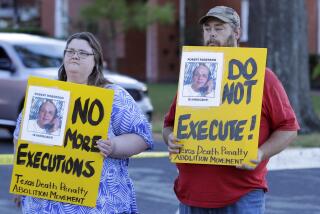Sedative’s Efficacy in Executions Questioned
- Share via
SAN JOSE — A federal judge deciding the future of lethal injection in California said Thursday that he was “troubled” that one of the drugs used during several executions had failed to quickly end inmates’ breathing.
During the third day of a trial on the constitutionality of lethal injection, U.S. District Judge Jeremy Fogel asked the state’s pharmacological expert how long a person should continue to breathe after being given 5 grams of thiopental sodium, the anesthetic that is the first of three drugs used for executions.
Some medical experts say the persistent breathing suggests that inmates were not properly anesthetized during an agonizing death, comparable to drowning.
“Not very long,” replied Brent Eakins, the state’s expert. “Say a minute or less.”
Then why, Fogel asked, have several inmates continued breathing much longer after receiving that massive dose? Fogel said that doctors observed Jaturun Siripongs, who was executed in 1999, breathing for five minutes after receiving the sedative.
The judge said he was not drawing any conclusions, but added: “This is just an anomaly that has troubled me ever since I came across it.... The doctors say they saw actual breathing.”
Medical experts who testified previously in the case have said the large dose of anesthetic should rapidly stop breathing, although an inmate could continue to live for 20 minutes or longer. Critics of lethal injection have suggested that in the absence of proper sedation, the second drug, which paralyzes inmates’ muscles, masks the pain of the third drug, potassium chloride, which shuts down the heart.
Fogel is presiding over a legal challenge to lethal injection brought by Michael Morales, who was condemned to die for the 1981 murder of Terri Winchell, a 17-year-old high school student from Lodi. The judge must assess Morales’ claim that the state’s lethal injection procedures present an unnecessary risk of “cruel and unusual punishment” in violation of the 8th Amendment to the U.S. Constitution.
Thursday was the state’s turn to have its experts counter earlier testimony suggesting that execution teams may have failed to properly administer the drugs in the past, subjecting inmates to severe suffering.
Pursuing his questioning, Fogel wondered aloud why inmates were not immediately killed by the prescribed dose of the potassium chloride, which he said was supposed to be “a lethal dose 100% of the time.”
In the executions of Robert L. Massie in 2001 and Clarence Ray Allen earlier this year, second doses of the deadly heart-stopping drug had to be administered, Fogel said.
“Assuming proper delivery, a person should die within seconds?” Fogel asked.
Eakins agreed and then questioned whether Massie was experiencing “effective” heart beats or just simply “agonal rhythm,” a slow and irregular beat as the heart dies.
Fogel persisted. With Allen, the final drug was given at 12:31 a.m., but Allen did not “flat line” on an electrocardiogram until seven minutes later, according to records of the execution at San Quentin State Prison. Fogel noted that Allen had to be given a second dose even though he was 76, a diabetic with a bad heart and confined to a wheelchair.
Eakins suggested that the inmate’s circulatory system might have been “in shock,” making delivery of the drug to the heart less effective. “There are a number of things that could be happening,” he said.
Fogel then wanted to know the degree of pain that would be inflicted by the final drug if a person were not anesthetized. The judge has said the Constitution does not demand a painless execution but one free of “severe degrees of pain.”
Eakins replied, “It should be very painful,” and described it as possibly producing a “burning sensation.”
Eakins also acknowledged that it would be best to have an anesthesiologist present at the executions to ensure the inmates are properly sedated.
“That would be ideal but that won’t happen in the U.S., because the AMA has prohibited that from happening,” Eakins said, referring to the American Medical Assn.’s position that it would be unethical for a doctor to participate in an execution.
Lawyers for the state have suggested that requiring an anesthesiologist to be present would end lethal injection executions, because it would be extremely difficult, if not impossible, to find one willing to participate.
Underscoring that point, the state called Dr. Robert Singler of Napa, Calif., an anesthesiologist who testified that he thought the state’s system for executing people was adequate to bring death without suffering. But he added that he would not participate because of ethical concerns.
Singler was one of two anesthesiologists who had agreed to be present at Morales’ execution, which was scheduled for Feb. 21, after Fogel said the state had to either have a doctor present or change its protocol to one drug only -- a heavy dose of barbiturate. The execution was called off after the physicians backed out.
Even though he was a witness for the state, Singler was hardly championing executions. He said he thought he could play a useful role at the Morales execution by replicating, as much as possible, hospital conditions “to make sure the execution was a humane process.” He said he participated in two rehearsals three days before the execution was to have taken place and made one suggestion about how to administer the drugs.
“Based on my clinical experience, I knew [Morales] would have felt no pain” if the procedure was carried out correctly, he said.
However, just a few hours before the execution was to go forward, Singler said Senior Assistant Atty. Gen. Dane Gillette, the state’s lead death-penalty lawyer, handed him a court order saying that if the doctors discerned that Morales was regaining consciousness, “they need to take all medically appropriate steps ... to make sure that Morales remains unconscious.”
“The way the outside world would view it ... was that I would have a responsibility to rescue a botched execution even though I knew it couldn’t happen,” Singler said. “That was beyond my limit.”
Earlier in the day, Fogel asked Columbia University anesthesiologist Mark Heath, who has lambasted the state’s execution procedures, how they could be improved.
Fogel couched a number of his questions in terms of “large mammals,” acknowledging that he understood that Heath might not respond if he asked directly how to kill a human. For example, the judge asked Heath, “Assume I wanted to euthanize a large primate ... in a reasonably short period of time, what would be the best barbiturate?”
Heath told the judge veterinarians typically use pentobarbital and suggested that a member of that profession could best address the question of dosage.
The judge’s questions suggest that he believes information based on what happens to animals being euthanized is relevant to the challenge. That could be significant in this case, because lawyers for the state attorney general’s office have argued forcefully that animal studies should be disregarded.
More to Read
Sign up for Essential California
The most important California stories and recommendations in your inbox every morning.
You may occasionally receive promotional content from the Los Angeles Times.











